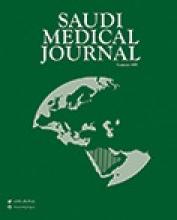Abstract
OBJECTIVE: The main objectives of this study were to review blood procurement, ordering, utilization, and causes of discarding blood in a University hospital and provide recommendations for improvement. The study was also aimed at sheding light on the frequency of seropositivity for certain disease markers in blood donors.
METHODS: This review comprised a retrospective 5-year analysis from January 1996 to December 2000 at King Fahad Hospital of the University, Al-Khobar, Kingdom of Saudi Arabia.
RESULTS: In this study, the most common donors were replacement (46%) and statutory donors (35%), while volunteer blood donors comprised a lower percentage (19%). There was a high crossmatch transfusion ratio (2.96:1) and similarly a high percentage of cancelled transfusions after crossmatching (66.2%). The 2 most commonly ordered blood components were packed red blood cells (45.7%) and random platelet concentrates (19.2%). The infective causes for discarding blood were: hepatitis B core antibody seropositivity (16.9%), hepatitis B surface antigen seropositivity (2.4%) followed by hepatitis C antibody seropositivity (1.5%), and rapid plasma reagin (serological test for syphilis) positivity (1%). The common non-infective causes of discarding blood in descending order or frequency were: expired unit shelf life (3.6%), positive donor antibody screen (0.7%), red blood cell morphological abnormalities (0.4%), and blood unit insufficient quantity (0.3%). Release of emergency uncrossmatched blood ranged at 0.6% during the study period.
CONCLUSION: Performing blood bank internal audits and reviewing statistics are vital tools for a successful blood transfusion service. Implementing policies such as type and screen and the maximum surgical blood-ordering schedules will lead to monetary savings and more effective blood utilization. Drives for enhancement of volunteer blood donors are recommended.
- Copyright: © Saudi Medical Journal
This is an open-access article distributed under the terms of the Creative Commons Attribution-Noncommercial-Share Alike 3.0 Unported, which permits unrestricted use, distribution, and reproduction in any medium, provided the original work is properly cited.






